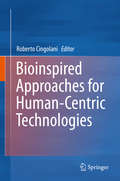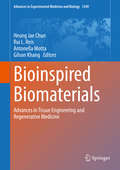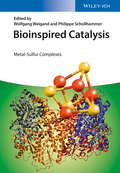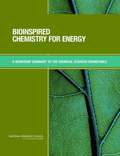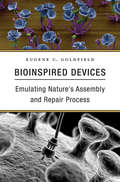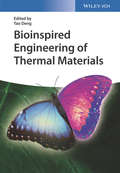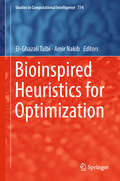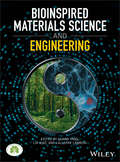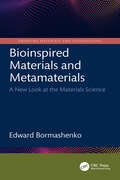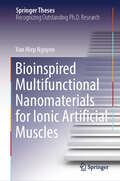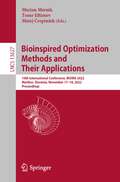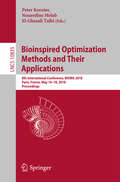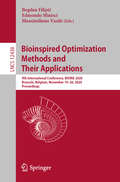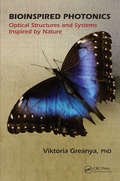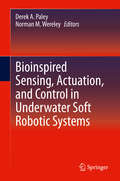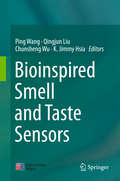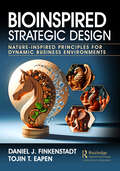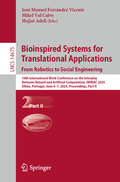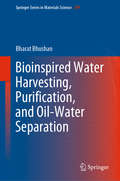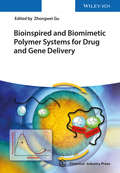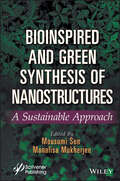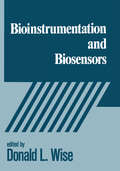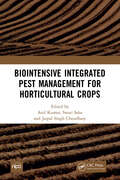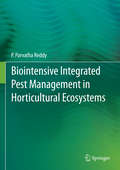- Table View
- List View
Bioinspired Actuators and Sensors
by Elizabeth Minoru Taya Van Volkenburgh Makoto Mizunami Shûhei NomuraFrom authors renowned in the fields of engineering and biology, this is the first book to integrate sensor and actuator technology with bioinspired design. Beginning with detailed descriptions of actuation and sensing mechanisms in plants and animals, the authors move on to apply these principles to synthetic design, offering in-depth knowledge of the development of state-of-the-art smart materials and devices. All of this is supported with a range of real-world applications, from tactile sensory systems in insects linked with the development of robotic hands, to the structural colour systems in nature used to inspire camouflage technology. Further examples are given of successful designs along with their integrated autonomous systems, such as flying and swimming, unmanned systems, and autonomous zero-energy building design. With a wide interdisciplinary appeal, this is an ideal resource for any student, practising engineer, or researcher interested in the connection between natural systems and synthetic design.
Bioinspired Approaches for Human-Centric Technologies
by Roberto CingolaniThe present book discusses topics related to research and development of materials and devices at nanoscale size and their respective application in medicine and biomedicine. The individual chapters give a detailed state of the art overview to the distinct topic. Apparently disconnected fields - life sciences, biomedicine, chemistry, physics, medicine and engineering - will be bridged with a highly interdisciplinary view onto each subject.
Bioinspired Biomaterials: Advances in Tissue Engineering and Regenerative Medicine (Advances in Experimental Medicine and Biology #1249)
by Rui L. Reis Heung Jae Chun Gilson Khang Antonella MottaThis book is the first of two volumes that together offer a comprehensive account of cutting-edge advances in the development of biomaterials for use within tissue engineering and regenerative medicine. Topics addressed in this volume, which is devoted to bioinspired biomaterials, range from novel biomaterials for regenerative medicine through to emerging enabling technologies with applications in, for example, drug delivery, maternal–fetal medicine, peripheral nerve repair and regeneration, and brain tumor therapy. New bioinspired hydrogels receive detailed attention in the book, and a further focus is the use of bioinspired biomaterials in the regulation of stem cell fate. Here the coverage includes the role of scaffolds in cartilage regeneration, the bioapplication of inorganic nanomaterials in tissue engineering, and guidance of cell migration to improve tissue regeneration. The authors are recognized experts in the interdisciplinary field of regenerative medicine and the book will be of value for all with an interest in regenerative medicine based on biomaterials.
Bioinspired Catalysis
by Wolfgang Weigand Philippe SchollhammerThe growing interest in green chemistry calls for new, efficient and cheap catalysts. Living organisms contain a wide range of remarkably powerful enzymes, which can be imitated by chemists in the search for new catalysts. In bioinspired catalysis, chemists use the basic principles of biological enzymes when creating new catalyst analogues. In this book, an international group of experts cover the topic from theoretical aspects to applications by including a wide variety of examples of different systems. This valuable overview of bioinspired metal-sulfur catalysis is a must-have for all scientists working in this hot field, including PhD students, postdocs and researchers.
Bioinspired Chemistry For Energy: A Workshop Summary To The Chemical Sciences Roundtable
by National Research Council of the National AcademiesFaced with the steady rise in energy costs, dwindling fossil fuel supplies, and the need to maintain a healthy environment - exploration of alternative energy sources is essential for meeting energy needs. Biological systems employ a variety of efficient ways to collect, store, use, and produce energy. By understanding the basic processes of biological models, scientists may be able to create systems that mimic biomolecules and produce energy in an efficient and cost effective manner. On May 14-15, 2007 a group of chemists, chemical engineers, and others from academia, government, and industry participated in a workshop sponsored by the Chemical Sciences Roundtable to explore how bioinspired chemistry can help solve some of the important energy issues the world faces today. The workshop featured presentations and discussions on the current energy challenges and how to address them, with emphasis on both the fundamental aspects and the robust implementation of bioinspired chemistry for energy.
Bioinspired Devices: Emulating Nature’s Assembly and Repair Process
by Eugene C. GoldfieldEugene Goldfield lays out principles of engineering found in the natural world, with a focus on how components of coordinated structures organize themselves into autonomous functional systems. This self-organizing capacity is one of many qualities which can be harnessed to design technologies that can interact seamlessly with human bodies.
Bioinspired Engineering of Thermal Materials
by Tao DengA comprehensive overview and summary of recent achievements and the latest trends in bioinspired thermal materials. <p><p> Following an introduction to different thermal materials and their effective heat transfer to other materials, the text discusses heat detection materials that are inspired by biological systems, such as fire beetles and butterflies. There then follow descriptions of materials with thermal management functionality, including those for evaporation and condensation, heat transfer and thermal insulation materials, as modeled on snake skins, polar bears and fire-resistant trees. A discussion of thermoresponsive materials with thermally switchable surfaces and controllable nanochannels as well as those with high thermal conductivity and piezoelectric sensors is rounded off by a look toward future trends in the bioinspired engineering of thermal materials. <p> Straightforward and well structured, this is an essential reference for newcomers as well as experienced researchers in this exciting field.
Bioinspired Heuristics for Optimization (Studies in Computational Intelligence #774)
by El-Ghazali Talbi Amir NakibThis book presents recent research on bioinspired heuristics for optimization. Learning- based and black-box optimization exhibit some properties of intrinsic parallelization, and can be used for various optimizations problems. Featuring the most relevant work presented at the 6th International Conference on Metaheuristics and Nature Inspired Computing, held at Marrakech (Morocco) from 27th to 31st October 2016, the book presents solutions, methods, algorithms, case studies, and software. It is a valuable resource for research academics and industrial practitioners.
Bioinspired Materials Science and Engineering
by Lin Xiao Guang Yang Lallepak LamboniAn authoritative introduction to the science and engineering of bioinspired materials Bioinspired Materials Science and Engineering offers a comprehensive view of the science and engineering of bioinspired materials and includes a discussion of biofabrication approaches and applications of bioinspired materials as they are fed back to nature in the guise of biomaterials. The authors also review some biological compounds and shows how they can be useful in the engineering of bioinspired materials. With contributions from noted experts in the field, this comprehensive resource considers biofabrication, biomacromolecules, and biomaterials. The authors illustrate the bioinspiration process from materials design and conception to application of bioinspired materials. In addition, the text presents the multidisciplinary aspect of the concept, and contains a typical example of how knowledge is acquired from nature, and how in turn this information contributes to biological sciences, with an accent on biomedical applications. This important resource: Offers an introduction to the science and engineering principles for the development of bioinspired materials Includes a summary of recent developments on biotemplated formation of inorganic materials using natural templates Illustrates the fabrication of 3D-tumor invasion models and their potential application in drug assessments Explores electroactive hydrogels based on natural polymers Contains information on turning mechanical properties of protein hydrogels for biomedical applications Written for chemists, biologists, physicists, and engineers, Bioinspired Materials Science and Engineering contains an indispensible resource for an understanding of bioinspired materials science and engineering.
Bioinspired Materials and Metamaterials: A New Look at the Materials Science (Emerging Materials and Technologies)
by Edward BormashenkoDevelopment of bioinspired materials and metamaterials has changed the philosophy of materials engineering and opened new technological possibilities, as they demonstrate properties that are not found in naturally occurring materials. This book examines advances in these emerging materials classes and investigates how their tailor-engineered properties, such as specific surface energy or refraction index, enable the design of devices and ultimately the ability to solve complex societal problems that are, in principle, impossible with traditional materials.The aim of this book is to survey the scientific foundations of the design and properties of bioinspired materials and metamaterials and the way they enter engineering applications. Introduces the physico-chemical foundations, theoretical groundings, and main equations of biomimetic and metamaterials science Describes how to develop and design these advanced materials and their applications Features end-of-chapter problems to help readers apply the principles Surveys achievements including metamaterials cloaking and the negative mass effect Emphasizes ecological aspects of materials science The text is intended for materials engineering students who have completed courses in general physics, chemistry, and calculus, as well as researchers in materials science and engineering.
Bioinspired Multifunctional Nanomaterials for Ionic Artificial Muscles (Springer Theses)
by Van Hiep NguyenThis book presents the development of four multifunctional nanomaterials: two electrolyte membranes with high ionic conductivity and robust mechanical strength and two electrode materials with excellent electrical conductivity and high capacitance. The integration of these materials has led to a substantial improvement in the performance of ionic actuators, enabling their application in four demonstrative models: soft fingers, inchworms, dynamic tensegrity structures, and dragonflies. Therefore, this multidisciplinary book is highly relevant to a wide range of scientific fields, including materials science, ionic actuators, soft robotics, bioinspiration, and biomimetics, as well as energy storage systems such as batteries, capacitors, and fuel cells.
Bioinspired Optimization Methods and Their Applications: 10th International Conference, BIOMA 2022, Maribor, Slovenia, November 17–18, 2022, Proceedings (Lecture Notes in Computer Science #13627)
by Tome Eftimov Marjan Mernik Matej ČrepinšekThis book constitutes the refereed proceedings of the 10th International Conference on Bioinspired Optimization Methods and Their Applications, BIOMA 2022, held in Maribor, Slovenia, in November 2022.The 19 full papers presented in this book were carefully reviewed and selected from 23 submissions.The papers in this BIOMA proceedings specialized in bioinspired algorithms as a means for solving the optimization problems and came in two categories: theoretical studies and methodology advancements on the one hand, and algorithm adjustments and their applications on the other.
Bioinspired Optimization Methods and Their Applications: 8th International Conference, Bioma 2018, Paris, France, May 16-18, 2018, Proceedings (Lecture Notes in Computer Science #10835)
by El-Ghazali Talbi Peter Korošec Nouredine MelabThis book constitutes the thoroughly refereed revised selected papers of the 10th International Conference on Bioinspired Optimization Models and Their Applications, BIOMA 2018, held in Paris, France, in May 2018. The 27 revised full papers were selected from 53 submissions and present papers in all aspects of bioinspired optimization research such as new algorithmic developments, high-impact applications, new research challenges, theoretical contributions, implementation issues, and experimental studies.
Bioinspired Optimization Methods and Their Applications: 9th International Conference, BIOMA 2020, Brussels, Belgium, November 19–20, 2020, Proceedings (Lecture Notes in Computer Science #12438)
by Massimiliano Vasile Edmondo Minisci Bogdan FilipičThis book constitutes the refereed proceedings of the 9th International Conference on Bioinspired Optimization Methods and Their Applications, BIOMA 2020, held in Brussels, Belgium, in November 2020. The 24 full papers presented in this book were carefully reviewed and selected from 68 submissions. The papers in this BIOMA proceedings specialized in bioinspired algorithms as a means for solving the optimization problems and came in two categories: theoretical studies and methodology advancements on the one hand, and algorithm adjustments and their applications on the other. Due to the Corona pandemic BIOMA 2020 was held as a virtual event.
Bioinspired Photonics: Optical Structures and Systems Inspired by Nature
by Viktoria GreanyaHarness the Wonders of the Natural World As our in-depth knowledge of biological systems increases, the number of devices and applications built from these principles is rapidly growing. Bioinspired Photonics: Optical Structures and Systems Inspired by Nature provides an interdisciplinary introduction to the captivating and diverse photonic systems
Bioinspired Sensing, Actuation, and Control in Underwater Soft Robotic Systems
by Derek A. Paley Norman M. WereleyThis book includes representative research from the state‑of‑the‑art in the emerging field of soft robotics, with a special focus on bioinspired soft robotics for underwater applications. Topics include novel materials, sensors, actuators, and system design for distributed estimation and control of soft robotic appendages inspired by the octopus and seastar. It summarizes the latest findings in an emerging field of bioinspired soft robotics for the underwater domain, primarily drawing from (but not limited to) an ongoing research program in bioinspired autonomous systems sponsored by the Office of Naval Research. The program has stimulated cross‑disciplinary research in biology, material science, computational mechanics, and systems and control for the purpose of creating novel robotic appendages for maritime applications. The book collects recent results in this area.
Bioinspired Smell and Taste Sensors
by Ping Wang Qingjun Liu Chunsheng Wu K. Jimmy HsiaThis book discusses the field of bioinspired smell and taste sensors which includes many new areas: sensitive materials, physiological modelling and simulation, and more. Similar to biological chemical sensing systems, bioinspired smell and taste sensors are characterized with fast responsive, high specificity and sensitivity. One of the most important parts of the field is that of sensitive elements originated from biological components, which enable the detection of chemical signals by mimicking the biological mechanisms. This book detailed describes processing, devices, recognition principles of sensitive materials, and concrete realizations. It is written for researchers, engineers and biologists who engages in interdisciplinary research and applications. Dr. Ping Wang is a professor at Zhejiang University, Hangzhou, China. Dr. Qingjun Liu is a professor at Zhejiang University, Hangzhou, China. Dr. Chunsheng Wu is an associated professor at Zhejiang University, Hangzhou, China. Dr. K. Jimmy Hsia is a professor at University of Illinois at Urbana-Champaign, Urbana, USA.
Bioinspired Strategic Design: Nature-Inspired Principles for Dynamic Business Environments
by Daniel J. Finkenstadt Tojin T. EapenOrganizations are commonly thrust into hostile operating environments where they are required to make strategic decisions that involve significant and costly tradeoffs. Such hostile environments may be endemic such as an economic recession or idiosyncratic such as a predatory action by an adversary. Many features of such hostile environments parallel those of living organisms that also demonstrate fine-tuned strategies to improve their survivability under adverse conditions. How can organizations use these “bioinspired strategies” to survive, and even potentially innovate? This book shows that the same three capabilities essential for the survival of living organisms in harsh environments – efficiency, resilience, and prominence – are also critical for organizations in their process of navigating through their own hostile environments. Throughout the book, the authors provide organizational executives with a systematic framework for thinking about strategic decision-making in a hostile environment leaning on analysis of real-world cases to draw out ontologies and methods for guiding their teams through disruptions, change management, innovation, and process improvements. In the first part, organizations are provided with a systematic approach to analyzing three survivability influences – forces, resources, and observers and their interrelationships. While all three influences are active across all organisms (and organizations), the exact nature of their interrelationship and the significance of each influence are unique to every organism (or organization). The framework helps organizations nail down the specific features of their operating environment that can help or hinder survivability by analyzing the three influences. Organizations can respond to external influences by developing three-pronged capabilities – efficiency, resilience, and prominence (ERP) – that respond to the three survivability influences. Organizations often struggle with identifying the appropriate strategies to apply under different conditions. Fortunately, nature provides several mechanisms that can be analogically applied to guide business strategies. The book contains many illustrations and examples of strategic principles observed among living organisms that can help an organization develop ERP capability. Finally, the book introduces seven strategic design heuristics – Combination, Elimination, Separation, Segmentation, Replication, Dynamics, and Maximization – observed in a living system that can be flexibly utilized to generate ideas to achieve strategic ends.
Bioinspired Systems for Translational Applications: 10th International Work-Conference on the Interplay Between Natural and Artificial Computation, IWINAC 2024, Olhâo, Portugal, June 4–7, 2024, Proceedings, Part II (Lecture Notes in Computer Science #14675)
by Hojjat Adeli José Manuel Ferrández Vicente Mikel Val CalvoThe two volume set LNCS 14674 and 14675 constitutes the proceedings of the 10th International Work-Conference on the Interplay Between Natural and Artificial Computation, IWINAC 2024, which took place in Olhâo, Portugal, during June 4–7, 2024. The 99 full papers presented in these proceedings were carefully reviewed and selected from 193 submissions. They were organized in topical sections as follows: Part I: Machine learning in neuroscience; artificial intelligence in neurophysiology; neuromotor and cognitive disorders; intelligent systems for assessment, treatment, and assistance in early stages of Alzheimer's disease and other dementias; socio-cognitive, affective and physiological computing; affective computing and context awareness in ambientintelliigence; learning tools to lecture; Part II: Machine learning in computer vision and robotics; bio-inspired computing approaches; social and civil engineering through human AI translations; smart renewable energies: advancing AI algorithms in the renewable energy industry; bioinspired applications.
Bioinspired Water Harvesting, Purification, and Oil-Water Separation (Springer Series in Materials Science #299)
by Bharat BhushanThis book presents an overview of arid desert conditions and natural mechanisms for water harvesting from fog and condensation, providing data on various bioinspired surfaces for water collection. It discusses consumer to military and emergency applications. It presents various designs for water harvesting towers and projections for water collection, and describes innovative approaches to bioinspired water desalination, water purification and oil-water separation.Fresh water sustains human life and is vital for health. However, water scarcity affects more than 40% of the global population and is projected to rise, especially in some of the world’s most impoverished countries. Additionally, water contamination is one of the most critical environmental and natural resource concerns of the 21st century. This book addresses these topics with a presentation of the development of sustainable and environmentally friendly bioinspired surfaces for water harvesting from fog and condensation, as well as bioinspired oil-water separation techniques for removing oil contaminants from oil-water mixtures and oil-water emulsions.Intended for novices as well as experts in the field, the book offers actionable insight for practitioners, solution seekers, and the generally curious alike. It serves as an excellent accompanying text for one-semester courses in biomimetics, water supply and management, or environmental engineering.
Bioinspired and Biomimetic Polymer Systems for Drug and Gene Delivery
by Zhongwei GuHere, front-line researchers in the booming field of nanobiotechnology describe the most promising approaches for bioinspired drug delivery, encompassing small molecule delivery, delivery of therapeutic proteins and gene delivery. The carriers surveyed include polymeric, proteinaceous and lipid systems on the nanoscale, with a focus on their adaptability for different cargoes and target tissues.Thanks to the broad coverage of carriers as well as cargoes discussed, every researcher in the field will find valuable information here.
Bioinspired and Green Synthesis of Nanostructures: A Sustainable Approach
by Mousumi Sen Monalisa MukherjeeBIOINSPIRED AND GREEN SYNTHESIS OF NANOSTRUCTURES This unique book details various ways to synthesize advanced nanostructures using green methods, explores the design and development of sustainable advanced nanostructures, and discusses the antimicrobial and antiviral applications. The future of the world depends on immediately investing our time and effort in advancing ideas on ways to restrict the use of hazardous chemicals, thereby arresting further environmental degradation. To achieve this goal, nanotechnology has been an indispensable arena that has extended its wings into every aspect of modernization. For example, green synthetic protocols are being extensively researched to inhibit the harmful effects of chemical residues and reduce chemical wastes. This involves the study of nanotechnology for artful engineering at the molecular level across multiple disciplines. In recent years, nanotechnology has ventured away from the confines of the laboratory and has been able to conquer new domains to help us live better lives. Bioinspired and Green Synthesis of Nanostructures focuses on the recent developments and novel applications of bioinspired and biomimetic nanostructures as functionally advanced biomolecules with huge prospects for research, development, and engineering industries. It provides detailed coverage of the chemistry of each major class of synthesis of bioinspired nanostructures and their multiple functionalities. In addition, it reviews the new research results currently being introduced and analyzes the various green synthetic approaches for developing nanostructures, their distinctive characteristics, and their applications. The book provides readers with an understanding of the recent data, as well as various strategies for designing and developing advanced nanostructures using a greener approach. Audience The core audience of this book include materials scientists, nanoscientists, nanotechnologists, chemical and biological engineers, biochemists and biotechnologists. Industry process engineers and scientists working in nanomaterial synthesis will find this book extremely valuable.
Bioinstrumentation and Biosensors
by Donald L. WiseThis reference text consists of contributed chapters by specialists directly carrying out research and development in this emerging field which joins advanced microelectronics with modern biotechnology. Chapters present novel biotechnology-based microelectronic instruments, such as those used for de
Biointensive Integrated Pest Management for Horticultural Crops
by Anil KumarThe book has covered recent techniques on bio-intensive integrated approaches of horticultural pest’s management. An attempt to compile information on non-chemical ways of pest management strategies including agronomic approaches to physical, mechanical, biopesticides, biocontrol agents, biorational pesticides etc. which are non harmful to environment and economically viable has been made. This book is a useful reference material for organic product producing farmers, researchers and students who are involved in bio-intensive pest management strategies.Note: T& F does not sell or distribute the hardback in India, Pakistan, Nepal, Bhutan, Bangladesh and Sri Lanka. This title is co-published with NIPA.
Biointensive Integrated Pest Management in Horticultural Ecosystems
by P. Parvatha ReddyThrough 'Green Revolution' in late 1960s, India achieved self-sufficiency in food production, but still the country has not achieved self-sufficiency in production of horticultural crops. Most of the growth in food production during the green revolution period is attributed to the use of higher levels of fertilizers and pesticides which are continuing to destroy stable traditional ecosystems. The challenge before the crop protection scientist is to increase yields from the existing land without harming the environment and resource base. This can be achieved by adopting eco-friendly Biointensive Integrated Pest Management (BIPM) strategy. BIPM incorporates ecological and economic factors into agricultural system design and decision making, and addresses public concerns about environmental quality and food safety. The benefits of implementing BIPM can include reduced chemical input costs, reduced on-farm and off-farm environmental impacts, and more effective and sustainable pest management. An ecology-based IPM has the potential of decreasing inputs of fuel, machinery, and synthetic chemicals-all of which are energy intensive and increasingly costly in terms of financial and environmental impact. Such reductions will benefit the grower and society. The present book deals with the most recent biointensive integrated approaches for pest management utilizing components such as bioagents [predators, parasitoids and pathogens (bacteria, fungi, viruses)], botanicals (biofumigation, oil cakes, FYM, compost, crop residues, green manuring and other organic amendments), arbuscular mycorrhizal fungi, physical methods (hot water treatment of planting material, soil solarization), cultural methods (crop rotation, summer ploughing, fallowing, intercropping, pruning, mulching, spacing, planting date, trap cropping, etc. ), biorational chemicals (pheromones) and resistant cultivars. This book can serve as a useful reference to policy makers, research and extension workers, practicing farmers and students. The material can also be used for teaching post-graduate courses.

